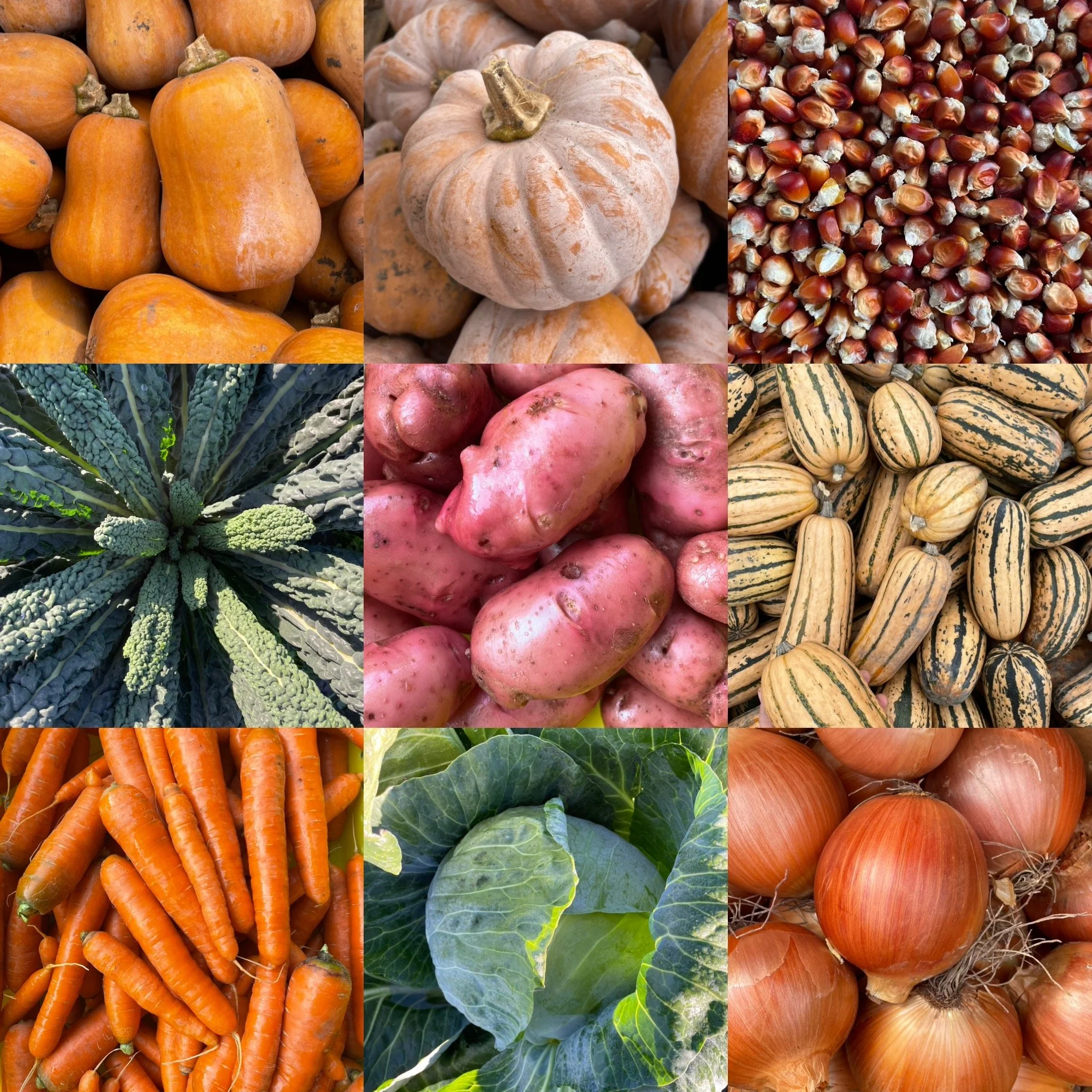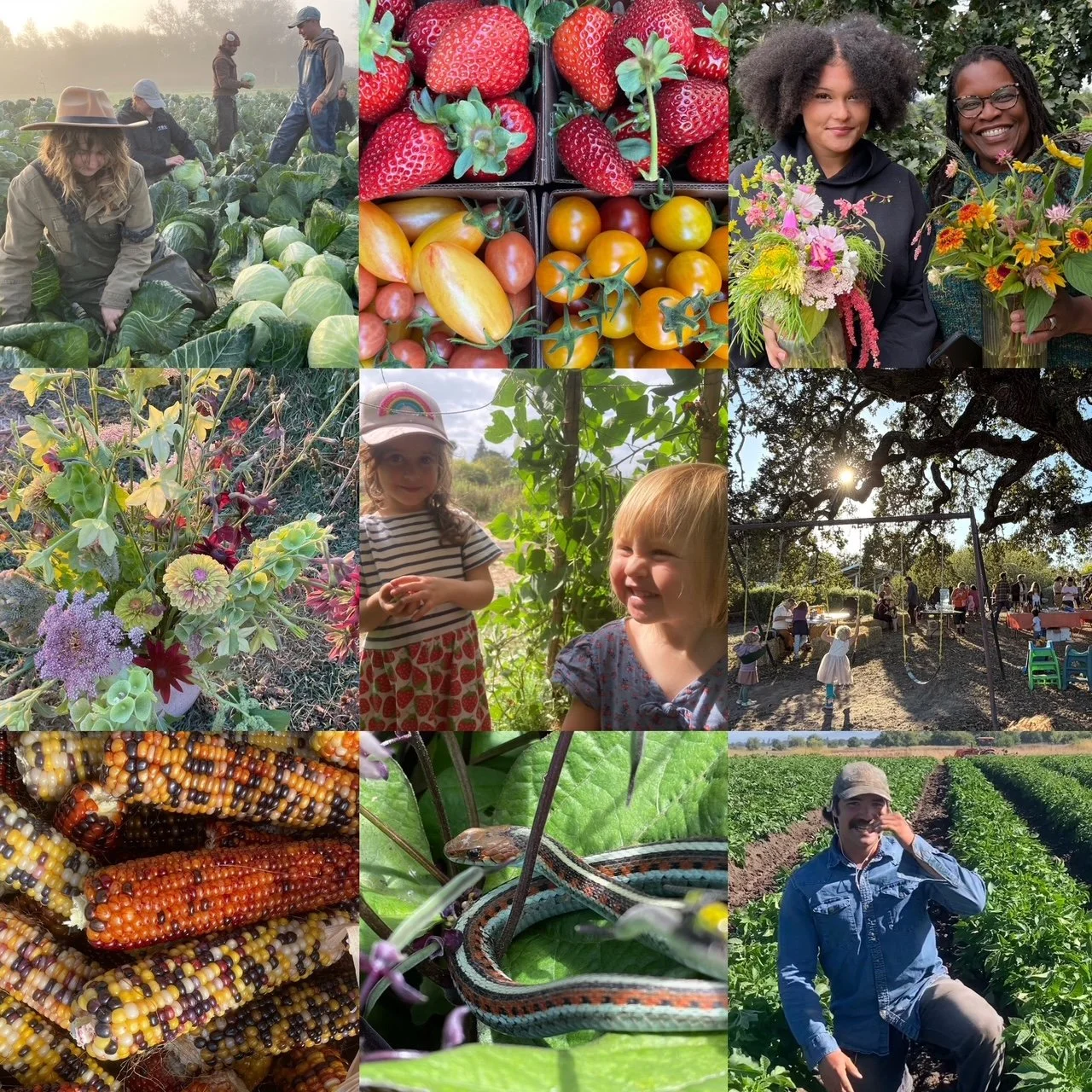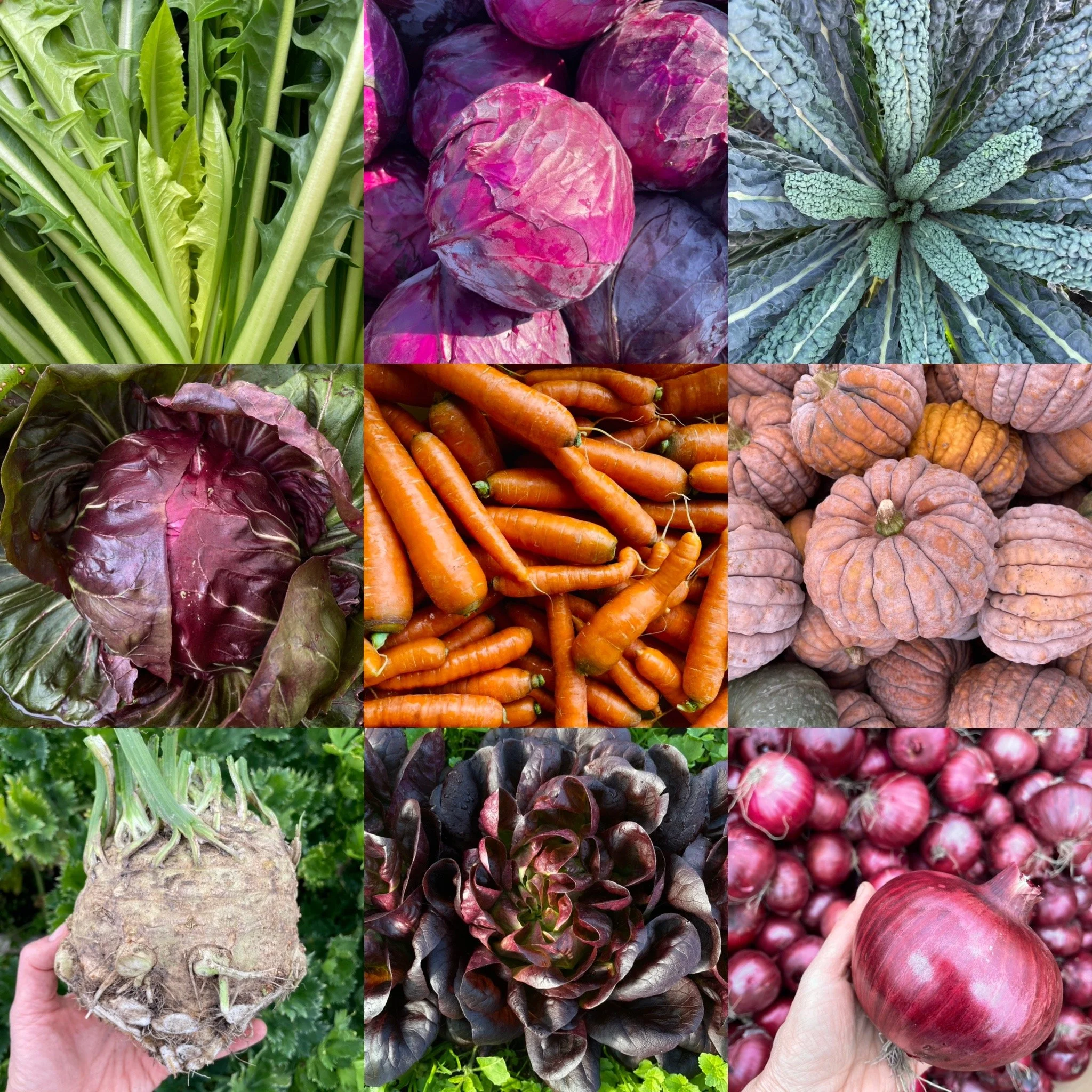LAST WEEK!
This is the last week of our 2025 CSA Program! The last pickup is this Tuesday, December 9th. Thank you all for making 2025 such a wonderful season!
THIS WEEK’S HARVEST
Garlic, Floriani Red Flint Cornmeal, Koginut Winter Squash, Honeynut Baby Butternut Squash, Honeyboat Delicata Winter Squash, Green Storage Cabbage, Celeriac, Jelly Potatoes, Desiree Potatoes, Calibra Yellow Onions, Carrots, Indigo Radicchio, Black Magic Dino Kale, Dandelion Greens, Red Salanova Butter Lettuce
BULK WEEK!
Pick-up will be a little different this week: We will be offering larger than usual quantities of potatoes, carrots, and winter squash so that you can fill your larders and eat from the farm on into the Solstice. We recommend bringing an extra tote bag this week!
U-PICK
This week, we put the garden to bed for the season. Thank you all for a wonderful year in the garden!
HARVEST NOTES
Honeynut Baby Butternut: It’s our first year growing these miniature golden butternut and we’re smitten. Halved and roasted they make a perfectly elegant single-serving, with a honey color and flavor that matches the best butternuts.
Koginut Winter Squash: These frosted beauties are one of the varieties bred by Row 7 Seeds. Koginut are similar to a butternut in flavor, and have an excellent storage life. Delicious roasted as wedges or halves.
NOTE: We recommend eating your Delicata before the other squash in the share this week! They have the shortest storage life and won’t be good for much longer, while the Koginut and Honeynut should keep for significantly more time.
Green Storage Cabbage: These giant green cabbages are frost-sweetened, and although they may be intimidating, we wanted to make sure you know that they keep exceptionally well. Consider them an investment in your larder, from which you can carve small, or large, slices as the need arises. To get you started on your cabbage, consider making the Comforting Cabbage and Farro Soup recipe below.
WHEN CAN I RESERVE MY SPOT FOR 2026?
We plan to open sign-ups in mid-to-late January 2026. 2025 CSA program members will be given the first chance to reserve a spot for 2026. Please encourage family or friends who would like to join next year to sign-up for the waitlist posted on the homepage of our website!
LIL’ WINTER MARKET
CSA member Hanna, The Wool Witch, will host a table of her creations for sale at Tuesday pick up! Come ready to shop Wool throw rugs, silk scarfs, natural dye kits, and other wooly plant dyed magic!
HELP SAVE GREEN VALLEY FARM + MILL!
As many of you know, West County Community Farm got its start at the beautiful Green Valley Farm + Mill, a property owned by a group of people committed to regenerative agriculture, education, and community building. The farm hosts Bramble Tail Homestead and Farmer Mai Nguyen. After a year of economic uncertainty, they are currently fundraising to help pay back one of their founding loans.
Below are some ways you can help Green Valley Farm + Mill keep thriving:
Come to the Benefit Concert this Sat, 12/6 for live music, dancing, and a silent auction. Gillian Grogan, Daniel Steinbock, and the Deep Thicket Dwellers are talented musicians and it’ll be a fun time!
Contribute to the Silent Auction for Saturday’s concert (contact Aubrie Maze: aubrie@gvfam.com
Donate to the GoFundMe and share it with your networks
Book an event at Green Valley — a staff retreat, family gathering, or wedding
Shop at the Marketplace if you’re nearby
COMFORTING CABBAGE AND FARRO SOUP
From Six Seasons by Joshua McFadden
To close out a chillier-than-usual year in which we’ve personally been obsessed with eating cabbage and cooking from Six Seasons, we wanted to share this cozy cabbage soup.
Note: this recipe makes a very modest 4 servings, so it’s great to double it if you want leftovers!
1 pound cabbage, savoy or green
Olive oil
1 medium onion, thinly sliced
Kosher salt and freshly ground black pepper
3 garlic cloves, smashed and peeled
1 sprig of rosemary or thyme (optional because I’ve forgotten it each time, and not regretted it)
1 tablespoon red wine or white wine vinegar
2/3 cup uncooked farro
About 4 cups homemade or storebought chicken or vegetable broth
1 tablespoon fresh lemon juice
Shaved parmesan, to finish
Cut out the cabbage core and finely chop it. Cut the leaves into fine shreds or about 1/8-inch ribbons. Heat 1/4 cup olive oil in a large pot or Dutch oven over medium heat. Add the onion and cabbage core, some salt and pepper, and cook, stirring frequently, until the onion starts to soften but is not yet browned, about 5 to 7 minutes. Add the garlic and cook another 3 to 5 minutes, until the garlic softens too. Add the shredded cabbage leaves and herb sprig, if using. Reduce the heat to medium-low and cover the pot and let it steam a bit to soften the leaves, then toss the cabbage to stir it well with the other ingredients in the pot. Cook, covered, until the cabbage is very sweet and tender, at least 30 minutes. Stir occasionally.
Meanwhile, in a small skillet, heat a glug of olive oil over medium and add the uncooked farro. Toast it, stirring, for a few minutes, until half a shade darker.
When the cabbage is ready, stir in the vinegar. Taste and season with more salt and pepper. Add toasted farro and broth. Bring mixture to a lazy simmer and cook for 25 to 35 minutes, until farro is tender and all the flavors are married. The soup will be very thick, but if you’d prefer more liquid, add another 1/2 cup broth or water. Taste and adjust seasoning again. Stir in lemon juice.
Ladle into bowls and finish each with a drizzle of olive oil and a shower of parmesan, with more parmesan passed at the table.
FARMER’S LOG
TREASURE
It was a bittersweet day today — the last Friday harvest of our 2025 season. This coming Tuesday’s pick-up will be the last pick-up of the year.
Each growing season is like a voyage, with us farmers and CSA members striking out together on a grand adventure. The community supported agriculture model that we practice here, that we ask you to practice here, is not a gimmick or a fad. It is a powerful and functional alliance between a community of neighbors and farmers.
We are one crew on this voyage. And that bond allows us to farm this land well, to farm it intentionally, and to farm for the future in very real ways.
So what did we, as a community, just do? What did we accomplish together?
First and foremost it was our biggest voyage yet. We grew 10.5 acres, as regeneratively as we know how, of healthy, nutrient dense food for 515 Sonoma County adults and 190 kids. It was a very bountiful year in the fields and our nets came up full.
But the catch is never the most valuable part of a voyage. The real treasures are the intangibles: The memories you made, the wisdom you earned, and the friends and connections you made along the way.
This year we welcomed 65 new households to the farm — many of whom said coming to the farm was the highlight of their week.
We sailed with our biggest crew yet, numbering 8 on the payroll with support from a motley crew of craftspeople, ringers, and friendly pirates. We welcomed Arabella, Riley, and Eric to the team who added immense skill and farmer wisdom. We learned and grew as farmers together, taught each other new shanties, and had each other’s backs throughout the long voyage and the gales.
We raised $4,260 in share price assistance funds, which helped members of our community enjoy a harvest share they may otherwise not have been able to afford. We raised $2,200 to tend the wild ecosystem of the farm, which went toward the planting of more native shrubs in our northern border hedgerow and more oak trees saplings — part of a larger project to nurture the next generation of grandmother oak trees on this land. We donated extra produce weekly to the Food for Thought Food Bank.
It was a wonderful year of growth for the capability of the ship itself. We invested in more advanced weeding equipment and tools and saw results immediately. We had the best year ever in our staple crops. We dialed in our overhead irrigation systems and paid down loans for our big tractor and new tillage implements.
And we took care of our most precious resource — our soil. We put down 96 tons of compost and seeded over 2,000 lbs of cover crop seed this fall, which, if they fair well this winter, will be able to produce over 48,000 lbs of carbonaceous biomass in the spring that will feed our soil for years to come.
Finally, and perhaps most gratifying to us, the farm continued to become, more than ever before, a place where people spent time and connected. Whether alone, with friends, or with family, it was a presence in your lives — a place to touch grass, to gather, to hang out with friends and let the kids run free.
Seeing so many of you lingering in the garden, picnicking under the oak trees, and playing on the new playground was all the treasure we needed from this year’s voyage.
Our one hope for your experience of the farm this year is that it included moments of connection between this land, the beings we share it with, and your heart.
This connection is so important for human beings and so hard to experience in the modern world.
Thank you for joining us on the voyage this year and helping to build a place where that connection can be felt and lived.
And now for our customary parting words…
If, in the dark season ahead, you feel pent up, like you need to get out of the house and stretch your legs, come visit the farm and stand still for a moment in a field.
There you will find silence, broken only by the screech of a hawk or the singing of the redwing blackbirds. A coolness will emanate up from the wet soil, chilling your knees. Before you will lay the sleeping farm, the soft contours of the land draped in a blanket of green (or underwater!).
But listen closely...
For within that slumber next season churns. The cover crop stretches its living roots deep into the soil where subterranean creatures break down this year's crop roots and residue, processing them — like so many memories — into the raw materials that will make up next year’s picnics under the oaks, next year’s memories, next year's bounty.
Listen closely and you’ll hear the land dreaming.
Now, it is time for your farmers to rest, to reflect, and to do a little dreaming ourselves. Thank you all so much for the memories this harvest season. Here is to many more to come.
See you in the fields,
David & Kayta

















